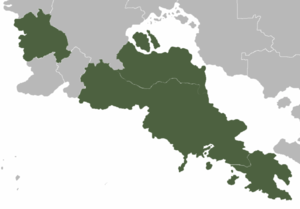Tierrosphere

The Tierrosphere is a predominantly South Cronan area that is considered to be under the historical, economic, cultural, and military influence of the Tierradorian Woqalate. The current extent of the Tierrosphere is widely agreed on as Tierrador, Ceylonia, Porlos, Istrenya, and Malentina, which had historically been dominated as former colonies or vassals by the Qabóri Woqalate. Other nations sometimes included are Umardwal, Tapakdore, and Arona. All five of the main Tierrosphere nations feature very similar characteristics culturally, as their dominant indigenous culture stemmed mostly from Pan-Qabóri civilization, the dominant South Cronan culture group. While the Tierrosphere is not a recognized international organization by the governments of the aforementioned nations, it usually is referred to in official documents and meetings between leaders, media organizations, and scholars within those countries.
Today, the term "Tierrosphere" is used to describe Tierrador's foreign policy position that is heavily opposed to foreign colonization in South Crona. Because of this, the region had been referred to as a "colonial dead zone," due to the tightly-knit relations between the nations that occupy it. The Tierrosphere sometimes is referred to as "Tierrador's backyard," and is an integral part to Tierrador's grand strategy.
Overview
As mentioned before, the Qabóri Woqalate dominated practically the entire South Cronan peninsula, implementing its military and economic strategies on the local tribes, but allowing for them to practice their respective cultures freely. Eventually, as influence grew and generations passed, many of the local tribes slowly became associated with the dominant Pan-Qabóri civilization, and by the dissolution of the first Qabóri Woqalate in the early 18th century, almost every major South Cronan culture group was a direct offshoot of Pan-Qabóri civilization. The term "Tierrosphere" was first coined in 1787 by Fanerian political theorist Jonathan Farrier to describe the continued influence in the Cartadanian colonies of Ceylonia and Porlos, the latter of which had sizable Fanerian influence thanks to their colony in Asteria. While Tierrador's economic and political influence had been reduced by the Occident in those former Qabóri colonies, their cultural influence still remained heavily, including the popularity of Qabóri-influence literature and art.
Ceylonia and Porlos
By the time Ceylonia and Porlos had gained their independence and got their economies and politics in order, they began to repair their relations with Tierrador, which had seen a massive economic upturn of its own. The economies of Ceylonia and Porlos would slowly become shaped by Tierradorian-influenced commerce, shipping, and general political activity, with Porlos going as far as to installing its version of a Woqalate. Talks of Ceylonia following suit were advancing, however continued influence from the Cartadanian government almost immediately put a stop to that, therefore, Porlos remained as the only Woqalate in the world for an extended period of time. As Tierradorian society slowly became more Occidentalized, so did Porlos and Ceylonia, due to their growing reliance on Tierradorian influence to keep their own nations afloat. The term "Tierrador's backyard" was first coined in the Taisgol Gazette to describe both of these nations. Today, Tierradorian influence still plays a key role in the day-to-day operations of both the Ceylon and Porlosi governments, along with the daily lives of their residents.
Istrenya and Malentina
Like Ceylonia and Porlos, Istrenya and Malentina had mostly been influenced by Qabór and its colonial history. However, as Qabór's influence in the North Songun basin area begin to dwindle, both countries began to distance themselves from the falling empire. Istrenya specifically had become more intertwined with Arcerion and its own sphere of influence, known as the Arcosphere. This began decades of competition between Tierrador and Arcerion in the late 19th century to early 20th century, over the North Songun basin and more specifically Istrenya and Malentina. The Istrenyan Crisis in 1959 saw both Arcerion and Tierrador cooperating to help Istrenya fight off communist insurgents, however the nations were truly more concerned with swaying the Istrenyan public towards their respective sides, not really paying much mind to the conflict at hand. Shortly after the Istrenyan Crisis was won by the Arco-Tierro-Istrenyan collaboration, Istrenya had begun funneling illegal activity through its border with Tierrador, triggering a national security crisis in the latter nation. What unfolded after was the Mosquito War, which saw TDF soldiers pouring into Istrenya. While Tierrador would get relatively far into Istrenya, domestic opposition and international pressure proved to be a massive drawback, leading to the TDF's withdrawal from Istrenya in 1970.
After the events of the Mosquito War, Tierrador and Istrenya would slowly build back relations during the 1980s and 1990s, and by 2002, Malentina would begin to be included in the economic activities of the Tierrosphere. Because of these nations' increased relations with Tierrador, their economies have boosted by a large percentage since the early 2000s, and Tierradorian influence had slowly but surely became a key role in Istrenyan and Malentine daily life.
Economic influence

Because of heavily-influenced historical reliance on Tierradorian commerce and trade, the path to Occidentalization of South Crona mainly began in Tierrador itself, with the exception of Ceylonia, due to it still being somewhat aligned with Cartadania. The trade policies of the Tierrosphere are loosely based on those of the Woqalate, and three of the five Tierrosphere countries use the Tierradorian-originated Ponča as their main currency. Tierradorian economic activity began to pick up in the 19th and 20th centuries throughout South Crona, as Tierradorian-based companies began to set up shop throughout the Tierrosphere countries. This began mostly with Porlos, as the sudden withdrawal and severance of ties with Cartadania practically left the country's economy in the gutter, and in an attempt to increase their weight in Cronan politics, Tierrador enlisted itself to help with rebuilding the Porlosi economy, and began establishing numerous economic aid and relief programs for Porlos. Because these programs would become very successful towards the start of the 1950s, Porlos began to rely heavily on Tierradorian exports and imports, which would boost their economy by a significant margin throughout the 20th century.
In Ceylonia, Tierradorian influence would fall under a similar chain of events to those of Porlos. However, in Ceylonia's case, the events would begin much earlier and would be drawn out over a long period of time. Ceylonia was granted its independence from Cartadania in 1813, following the Ceylon Peace Accord. The Cartadanian withdrawal from Ceylonia was done in a much more peaceful and mutual effort than the abrupt withdrawal from Porlos, allowing for Cartadanian influence to remain in the country. Ceylonia and Tierrador had very rocky relations to start, as Tierrador was in the midst of the violent Takosenic Wars, while Ceylonia was undergoing its own civil conflicts between different tribes. However, as both countries stabilized, so did their relations, and by the beginning of the 20th century, Ceylonia had seen a massive spike in Tierradorian commercial and economic influence. In 1930, Ceylonia would adopt the Ponča as its official currency, stemming from the severe hyperinflation of the Ceylon Real, which nearly triggered a nationwide economic crisis. Despite the advancements made with the help of Tierrador, the Ceylon public would become discontent with what they believed was re-colonization, which triggered the Ceylon Steel Crisis, which lasted for almost 20 years. Even though the public was against Tierradorian influence, it still would persist, and various economic reform projects sponsored by Tierrador would be approved by the Ceylon government. In 1967, the Autoestrada highway system would break ground throughout Ceylonia, with $14 billion in Tierradorian funds being granted to the Ceylon Department of Transportation. Similarily, the Autoosorouutaiki system of Porlos would also begin construction in 1971, with a large percentage of the costs being funded by Tierrador.
Tierrador's influence did not necessarily reach Istrenya and Malentina until the end of the 20th century, specifically in the 1990s. By that time, both countries were considered economic backwater, as the government of Arcerion would begin to sour its relations with both countries, which would result in less economic influence from it. In response to this, Tierrador began to exert its commercial influence, of which it already had stable standing in Istrenya due to slowly-increasing relations in the 1970s, but they would be entering new turf in Malentina. Tierrador would help to expand Istrenyan and Malentine petroleum drilling industries, and in 1996, Tierradorian-funded Istrenco would strike oil on its Songun coast, boosting its economy by the early 2000s.
Today, the Tierrosphere follows the Tierradorian model of a primarily mixed market economy that equally focuses on agriculture, mineral extraction, and industrial aspects with heavy focus on advancements in technology and safety regulations throughout the area. Due to the cultural similarities of the five Tierrosphere countries, there has been little to no backlash against it.
Political and military influence
Much of the Tierrosphere's political systems are strictly based on political traditions dating back to their time as Qabóri colonies, with some Occidental characteristics developed either by colonization or simple influence. It is widely believed that the Woqalate has some form of control over the governments of the Tierrosphere, however the Teklan has denied these rumors, and consistently refutes those statements by reminding the world of Tierrador's main goal of providing free, fair, and democratic societies to the members of its sphere of influence. Despite this, many still believe that there was heavy Tierradorian influence in the 2019 Istrenyan presidential election, which saw incumbent President Ambolia Ash'wacaí winning a third term, the first Istrenyan President to do so. Ash'wacaí's third term saw a significant increase in Tierradorian-funded infrastructure projects, which were authorized by her administration, in the midst of major criticism from the international community. The subsequent election was marred in controversy, with origin-unknown election interference meant to help Ash'wacaí win a fourth term failing to do so, resulting in moderately anti-Tierroshpere advocate M'kole Tysh'le winning the election.

Within Porlos, Ceylonia, Istrenya, and Malentina, the topic of reliance on Tierradorian influence is a large and divided subject throughout those countries. During an election, citizens will typically decide their ideal candidate choice based on their opinion of their country's relationship with Tierrador. Generally, South Cronans are in favor of their country's relationship with Tierrador, due to the economic and social prosperity associated with it.
Tierrador has had considerable military influence over the countries in the Tierrosphere. As of 2035, the TDF possesses 5 military bases in Porlos, 3 in Ceylonia, and 1 each in Istrenya and Malentina. All five Tierrosphere nations, along with Alstin, are a part of the South Cronan Mutual Defense Treaty, which guarantees military support and defense to each of its members in the event of a foreign invasion.